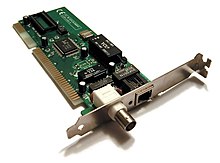10BASE2

10BASE2 , also Thin Ethernet , ThinWire or Cheapernet , is the further development of the network technology 10BASE5 (Thick Ethernet). A thin, flexible coaxial cable (RG-58) with a diameter of approx. 6 mm was used as the transmission medium . It was used as an alternative to 10BASE5, which was mechanically more inflexible, thicker (approx. 1 cm in diameter) and significantly more expensive due to the high material costs. The lower price resulted in 10BASE2 being often referred to as Cheapernet .
While 10BASE5 is connected to the computer systems to be connected by piercing the cable, T-pieces and BNC connectors were used for 10BASE2 . With smaller bending radii, simple wall sockets ( Ethernet connection socket ) that loop the branch line into the line when plugged in, easier installation technology and significantly cheaper hardware (hubs, network cards, cables, no need for transceivers), 10BASE2 (and thus also Ethernet) could be integrated into the 1980s prevail on the market. It was later replaced by more flexible and faster variants; IEEE 802.3 has advised against new installations since 2011 .
10BASE2 networks must always use a 50 ohm BNC terminator be completed (Terminator); if the termination was incorrect or not available, signal reflections caused transmission errors.
topology
10BASE5 and 10BASE2 require an electrical bus topology - a continuous cable runs past all stations. This reduces the cabling effort, since a cable only has to be laid to the next station. At the same time, the susceptibility to failure increases, since a defect in the cable or on a network card usually disrupts all stations in the segment. Because of this susceptibility to failure, 10BASE2 was later replaced by 10BASE-T with twisted pair cables that use a star topology - each station has its own connection to the repeater hub. The hub copies incoming bits from the respective sender to the other ports and thus only creates the required point-to-multipoint connection temporarily. Ports with short circuits or constant transmitters ( jabber ) are automatically decoupled.
Network devices with an AUI port require a transceiver to be connected to 10BASE2 . Often this was integrated into the network card.
Specifications
- Characteristic impedance: 50 ohms
- Cable designation: RG 58
- Maximum segment length: 185 m
- A maximum of three segments with a maximum of 90 (30 stations per segment, according to the 5-4-3 rule ) connected stations
- Minimum distance between the T-pieces: 0.5 m.
- Maximum distance between bus connection (T-piece) and transceiver approx. 30 cm.
- Before a station can start transmitting a data packet, it must wait until the bus is free. This means that all stations in a segment share the available transmission rate.
- If two stations start transmitting a data packet at exactly the same time, a collision occurs.
- 10BASE2 works in half duplex mode
- The maximum transmission rate of 10BASE2 is 10 Mbit / s.
In the case of cabling systems, such as those with EAD plugs, plugging in the connection cable disconnects the fixed cabling in the junction box and reroutes it via the connection cable. The connection cables must therefore be included twice in the maximum segment length. The BNC plug at the other end of the connection cable forms the T-piece, so the maximum distance between the bus connection and the transceiver is not exceeded. The cable length between the junction boxes can be very short, as the connection cable means that the minimum distance between the T-pieces is maintained.
In well-used network segments, the collisions that occur reduce the usable bandwidth by a few percent. If collisions occur excessively, the segment is considered to be overloaded.
literature
- Jörg Rech: Ethernet. Technologies and protocols for computer networking, 3rd updated edition, Heise Zeitschriften Verlag GmbH & Co KG, Hanover 2014, ISBN 978-3-944099-04-0 .
- Klaus Dembowski: Local Networks. Handbook of complete network technology, Addison-Wesley Verlag, Munich 2007, ISBN 978-3-8273-2573-0 .
- Herbert Bernstein: Information and communication electronics. Walter de Gruyter GmbH, Oldenbourg 2015, ISBN 978-3-11-036029-5 .
- Christoph Meinel, Harald Sack: Internetworking. Technical basics and applications, Springer Verlag, Berlin Heidelberg 2012, ISBN 978-3-540-92939-0 .
- Tony Kenyon: High-performance Data Network Design. Design Techniques and Tools, Butterworth Heinemann, Woburn 2002, ISBN 1-55558-207-9 .
Individual evidence
- ↑ IEEE 802.3-2012 10. Medium attachment unit and baseband medium specifications, type 10BASE2
See also
Web links
- Ethernet standards from IEEE 802.3 (accessed July 27, 2017)
- Cable and connector technology - Ethernet 10Base2 (accessed on July 27, 2017)
- Thin Ethernet: 10BASE2 (accessed July 27, 2017)
- What is 10BASE2 Standard (accessed July 27, 2017)



